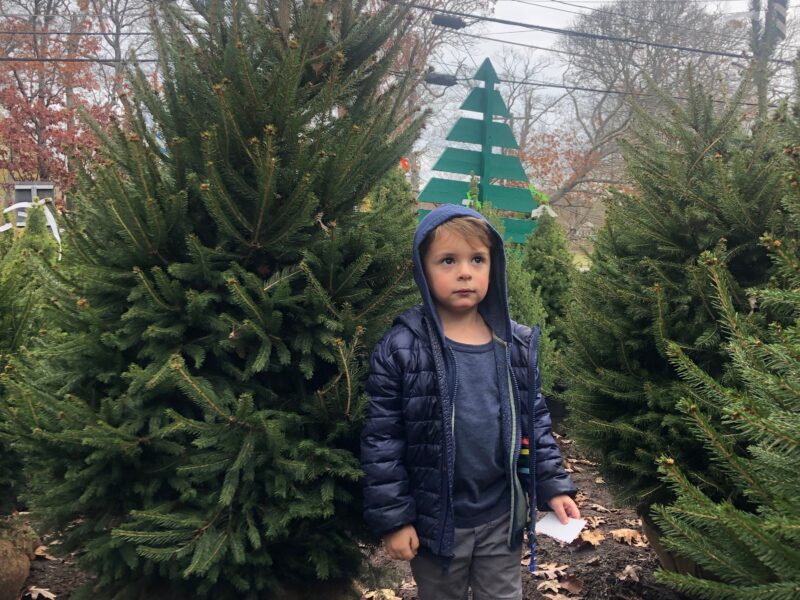

“Gee. Do they still make wooden Christmas trees?” – Linus, “A Charlie Brown Christmas”
If all you want for Christmas is a break from hearing bah humbug news about climate change, Christmas trees are the perfect respite. While the typical Christmas conifer does contribute to greenhouse gas emissions, a few tweaks to our tradition can make it greener, and sometimes even help fight climate change.
When deciding between real vs. fake, there are a few factors to consider. The environmental impact of a real tree depends on how far it travels to get to you, whether or not it’s grown without pesticides, and how you dispose of it after the holiday. The impact of an artificial tree depends primarily on how many times you reuse it.
One doesn’t usually think of growing a tree for almost 10 years only to be hacked down for a couple of weeks of Yuletide pleasure as “sustainably sourced.”
But a tree is a tree.
Despite its short time in the ground, the Rainforest Alliance says that a Christmas tree is just as effective at trapping planet warming carbon emissions as any other tree. A real tree releases oxygen into the atmosphere and removes about 20 pounds of CO2 over the course of its lifetime, thus offsetting the CO2 it takes to produce. It also helps clean the air, improve soil and provide wildlife habitat.
Always buy local. While trees coming from Pennsylvania and small farms in upstate New York produce less greenhouse gas emissions than one trucked in from Canada, the East End has four good Christmas tree farms with a big selection of Douglas, balsam and Fraser fir, as well as a variety of hearty spruces.
Don’t let pesticides poison your Yuletide celebration. Conventional Christmas tree farms use a lot of pesticides, many of which are the worst kind. The Center for Biological Diversity states that eight of the most harmful pesticides that are still legally available for tree farms make up 85 percent of the total amount used. Yikes! This chemical-filled Christmas tradition also contaminates groundwater and harms wildlife.
Not to play favorites, but Matt’s Christmas Tree Farm in Manorville is the only tree farm on Long Island that doesn’t use pesticides on its trees. Matt doesn’t refer to himself as an organic tree farmer but says, “I just don’t want to poison the ground water.” He adds, “We apply horticultural oil in the spring, then buy ladybugs to eat aphids.”
A Christmas tree may be the biggest piece of trash you’ll have to deal with all year, but also one of the easiest to dispose of sustainably. It’s inherently compostable. Take it to the Southampton or East Hampton recycling center for free and they’ll grind it into carbon rich mulch. Or drop it off in a nearby forest or your backyard for animals to hide in and build nests.
If you’re one of the 80 percent of Americans who celebrate the holidays with an artificial tree, they can be problematic. Aside from creating almost eight times the greenhouse gas emissions of a real tree in production, most of them are made of steel and PVC. Despite claims that PVC is “recycled,” they’re never recyclable and release a slew of toxic chemicals into the atmosphere. Nearly 90 percent of artificial trees are shipped all the way from Santa’s sweatshop in China, resulting in huge amounts of carbon emissions along the way.
If you’ve already done the dirty deed and have, say, a silver disco tree (my favorite), there’s one very simple way to make it more eco-friendly. Keep it. The longer you use it, the more sustainable it becomes. If you reuse for at least 10 Christmases, its environmental impact can be lower than that of a real tree.
For an absolutely zero impact tree, there are a few creative alternatives that can help protect the endangered white Christmas:
Decorate an indoor tree that you already have. No need to stick to the usual conifer when there’s a ficus tree waiting to sing “Fa La La.” Drape it with tinsel, string lights around its pot, add a star at the top, and call it a day.
Do the Charlie Brown thing. Ask people at the tree farm to show you the less-than-perfect trees that are headed to the chipper. Save a tree and maybe even save yourself a few dollars.
For a negative carbon footprint (i.e. a tree that absorbs more carbon than it pollutes), shrink your tree. A potted Christmas tree, which starts out smaller, is the gift that keeps on giving. After the holidays, bring it outside to soak up CO2 all year long until you invite it back into the house next year. When the tree grows too big to haul inside, plant it in the back yard and start the process over again. Andra Jenkins of the Springs, who’s on her third year of this approach, says, “I like to watch past Christmas trees growing outside year by year as my son grows.”
Or get really serious about tree planting and buy one with its root ball attached. They tend to be bigger than potted trees and are a one shot deal inside. After Christmas, replant it outside where it will continue to absorb carbon dioxide, produce oxygen, and provide a home for birds. Disclaimer: These take more effort. Because live trees really don’t like being inside, bring it in just before the holiday and keep it inside for about a week.
Now that you have a fresh local conifer (or not), don’t smother its branches in bling. Ornaments are stuff and stuff is usually made in China. Rather than buying perfectly matching Christmas baubles, the type you see in bank lobbies, shop your attic and keep the quirky ones. The scruffy ones with the sheen worn off. The third grader’s art projects heavy on glue and painted macaroni. An ornament you’d never hang if it weren’t for the memory of who gave it to you. It’s the hodgepodge that’s part of the charm.
If your tree is feeling naked, make ornaments out of glimmer shells from the beach, pine cones from the woods or scraps of colorful ribbon left over from wrapping.
Save energy by stringing smarter lights. Christmas lights in the United States use more electricity than El Salvador does in an entire year. Try LED lights which now have a warmer hue and are 90 percent more energy efficient than traditional holiday lights.
Ironically, un-environmental Christmas trees could be their own demise. Last February, on a Christmas tree farm in the foothills of the Sierras, seedlings that were planted in the middle of yet another extreme drought all died by July. In August, the massive Caldor wildfire reached that same family farm and destroyed 40 percent of their larger trees. Added to that was a fungus spreading amongst the farm’s Douglas firs due to higher temperatures. Sadly, this farm is more canary-in-the-coal-mine than anomaly.
Christmas trees may be just an environmental drop in the bucket compared with the climate impact of air travel and shopping during the holiday season, but doing them sustainably this season will still help protect this massive Christmas tree farm we call Earth.
The Nature Conservancy's Plant a Billion Trees Campaign (nature.org): For about $2 a tree, give the planet a gift through TNC’s forest restoration program. Or Gift a Tree to someone else who wants to help conserve critical forests and support biodiversity.
Zuhoski Farms (zuhoskitreefarm.com): Grows 15 acres of Douglas fir just for Christmas. Few potted trees, but Santa visits on weekends. Treat yourself to popcorn and cider.
Shamrock Christmas Tree Farm (shamrockchristmastreefarm.com): 2,500 trees, mostly Douglas fir (it’s not native but has thrived on Long Island for a long time). Some Fraser fir. They sell 30-40 trees with root bulb attached as well.
Matt’s Christmas Tree Farm (Mattschristmastreefarm.com): This is the real deal. No warehouse of ornaments from China and Christmas bling, 5,000 to 10,000 organic trees, mostly Norway and white spruce. Several hundred small potted trees.
Mike’s Christmas Tree Farm (Mikeschristmastreefarm.com): Right next door to Matt’s. Not organic but the largest the selection of potted trees out east AND the biggest trees available in pots. 7,000 trees to cut.
 More Posts from Jenny Noble
More Posts from Jenny Noble